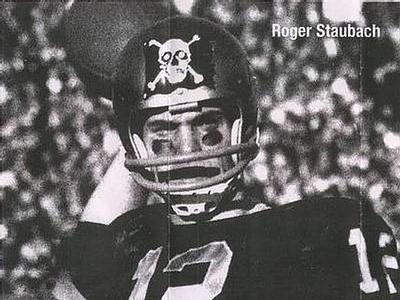

Navy
The Mysterious (one game) Helmet Design that Launched a Superstar
Midshipmen’s 1962 “Jolly Roger” Helmet
|
|
|
As soon as this
very first 1962 Navy “Jolly Roger” authentic helmet reproduction rolled off the
assembly line recently at the ole Helmet Hut / Historic Helmet factory the
entire workforce surrounded it in tributary awe. The factory is generously
comprised of well seasoned craftsmen who grew up “old school.” They have such
glorious memories as hoping, in the late 1950s and 1960s, that their next week’s
issue of Sports Illustrated would feature color (versus the normal black and
white) photographs along with the football stories. They remember adjusting the
antenna to get better reception for the Saturday or Sunday game (singular noun
intended) and hoping they would not have to get up from the sofa too often to
adjust the vertical hold control. And they certainly remember the legendary
gridiron battles between Army and Navy especially those in which Roger Staubach
commandeered the Midshipmen to three consecutive victories over their arch
rivals. In their own words, which are spoken with the wisdom of having “been
there” when it all happened: “this is not only one of the most interesting
and striking helmet designs ever worn in the history of college football it is
also the helmet that was worn during one game only – the game that Roger
Staubach became a nationally recognized star!”
|
|
|
Roger attended junior college in 1960 to improve his academic skills. He entered the Naval Academy the following year and excelled playing on Navy’s freshmen Plebe team (the NCAA did not allow freshmen to play on the varsity squad during that era). Entering his sophomore season in 1962 he was listed as the team’s third string quarterback. After the team started out poorly with one victory and two defeats Roger received his first starting opportunity and led Navy to a victory over Cornell. Roger continued to start and play well for the remainder of the season culminating in his tremendous performance while leading Navy to a resounding 34 – 13 victory over their legendary rival Army in front of a nationwide television audience.
The unusual helmet markings Roger and his teammates wore that day were designed by their somewhat controversial head coach Wayne Hardin. During his six year stint at the helm Hardin seemed to take special pleasure in taunting or mocking the rival Army team by adding special slogans or symbols on the Navy uniforms for their annual battle (see Dr. Del Rye’s 6/5/2005 column http://www.helmethut.com/060505.html to read more about this unusual ritual). During Hardin’s tenure Navy beat Army five out of six times while the traditionally conservative Naval Academy administration conveniently looked the other way as Hardin implemented his uniform shenanigans each year for the big game.
|
|
|
The 1962 Navy “Jolly Roger” helmet features unique, predominately black hued, mysteriously eerie symbols that contrast perfectly against the team’s traditional unadorned brilliant sparkling gold shell. The independent left and right helmet side symbols are written in Chinese and are interpreted in English as “win” (meaning defeat) and “Army.” As noted in Dr. Del Rye’s previously mentioned column the use of the Chinese language by Hardin was a not too subtle mocking gesture to Army’s head coach Paul Dietzel who invented the scrambling style defense nicknamed “The Chinese Bandits” while at LSU. Dietzel brought this style defense with him to Army and claimed that it would effectively contain the Navy offense.
Although it
now seems perfectly fitting, the helmet’s front side “Jolly Roger” pirate
flag symbol was not meant to relate specifically Roger Staubach.
The
“Jolly Roger” flag often displayed death or scary images (some images were
commonly found on gravestones of the time) - skulls, bones, swords/daggers,
and also hourglasses. While bones and weapon images obviously were signs of
death, the hourglasses were used to denote that time was running out for the
pirates' enemy to surrender before the pirates were unleashed upon them. The
main reason for the pirate flag was to make the enemy surrender without much
of a fight, if at all, so the more fearsome the flag (or the pirate's
reputation too) then the chances were higher of an initial surrender.
Original pirate flags were personalized or unique for each pirate ship. Navy
head coach Wayne Hardin picked one of the most notorious of all pirate flags
that flew for the pirate ship captained by Richard Worley. In September of
1718, Richard Worley and a group of 8 others set out in a ship that was
barely seaworthy from New York down the coast and up the Delaware River.
Soon, the crew's size had increased to 12 and later to 25. They had taken on
and transferred to a much nicer ship. Worley and his crew were captured when
they mistook 2 ships as merchants. After receiving a tip to Worley's
whereabouts, the Governor of North Carolina had sent the 2 ships out to trap
him. Fighting to the end, all of the crew died except Worley and one other
member. Both were hanged the very next day, February 17, 1719.
 |
We hope you will enjoy this Navy “Jolly Roger” helmet. It helped launch the legendary college career of a future Heisman Trophy winner and sports icon. It will now also be known as the one helmet introduction that brought normal production activity to a grinding halt at your vintage “old school” helmet factory.
If interested in any of these Navy helmets please click on the photos below.